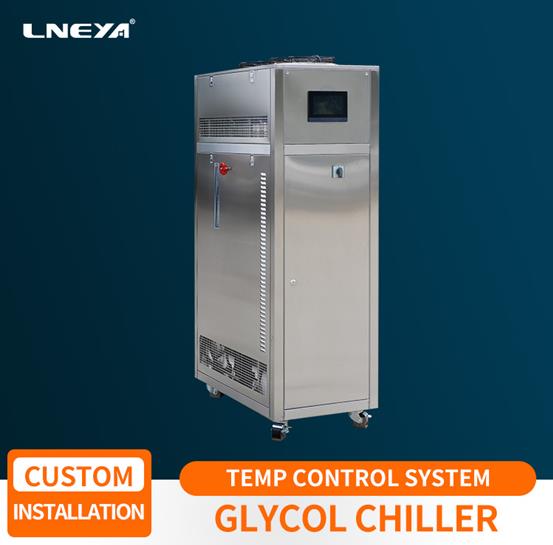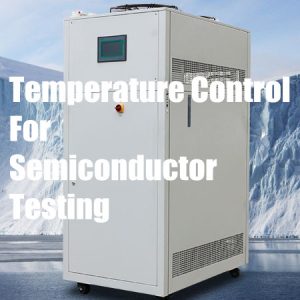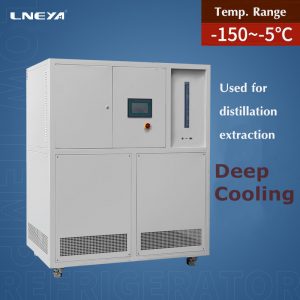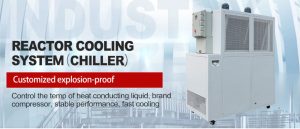The main purpose of the ethylene glycol chiller for the heating and cooling unit of the reactor
The glycol chiller is suitable for
high-purity metal, rare substance purification, laboratory environment
simulation, magnetron sputtering, vacuum coating and other industries. Large
cryogenic pump units can provide a cooling environment for laboratory instruments.
Cryogenic liquid circulation equipment that adopts mechanical refrigeration. It
has the function of providing cryogenic liquid and cryogenic water bath.
Combined with rotary evaporator, vacuum
freeze-drying box, circulating water multi-purpose vacuum pump, magnetic
stirrer and other instruments, it can perform multi-functional chemical
reaction operations and drug storage at low temperatures. The reactor heating
and cooling device can be used in conjunction with a variety of instruments, with
large cooling capacity, fast cooling speed, low energy consumption, greatly
improving work efficiency; the flow rate of the glycol chiller of the reactor
heating and cooling unit can be adjusted and can be customized. According to
user requirements, there is a reasonable match between low temperature and
cooling capacity, and low temperature and container capacity. Can meet the
actual needs of different users.
The main purpose:
1. It can provide ultra-low temperature and
constant temperature circulating liquid for double-layer glass reactor,
stainless steel reactor, rotary evaporator and other instruments and equipment.
2. Provide a constant temperature
experiment place for glass containers and glass reaction devices.
3. Provide constant temperature test field
source for applications in petrochemical and other industries.
4. It can perform low temperature cooling
and temperature control on the power and light source parts of the electron
microscope.
5. It can perform low temperature cooling
and temperature control on the heating part of industrial machinery.
Points to pay attention to when choosing a
glycol chiller for the heating and cooling unit of the reactor:
1. Choose the circulating pump model
according to the required coolant volume. Of course, the larger the capacity
and the lower the temperature, the higher the price.
2. According to the different temperature
requirements of the experiment, choose a cryopump with the corresponding
temperature control range. The lower the temperature, the higher the price of
the pump, and the low temperature of the heating and cooling device of Wuxi
Guanya reactor can reach -120℃.
3. Whether the test solution is corrosive,
if it is a strong acid/alkali type solution, you need to purchase a
corrosion-resistant reactor heating and cooling device.
Summarize
The above is the main purpose of the
ethylene glycol chiller for the heating and cooling unit of the reactor and the
matters needing attention when purchasing. If you have equipment requirements,
please contact us sales@lneya.com.
Related recommendations
-
Changes in temperature control methods during semiconductor testing
1651As the use of semiconductor devices expands into new areas, such as automotive electronics, stricter requirements are imposed on their performance. Example: Devices are now required to operate at very low temperatures (about -40°C). To determine w...
View details -
Practical application of different compressors in the industrial chiller industry
1414In the current refrigeration industry, the efficiency of the equipment is closely related to temperature. LNEYA tells you that the efficiency of the refrigeration equipment required under control has been improved. Then, the selection of the compr...
View details -
Precautions for operation of ethylene glycol utra-low temperature chiller at minus 30 degrees
1642The minus 30 degree ethylene glycol utra-low temperature chiller is a device that is used more in the pharmaceutical and chemical industry. When using it, you need to pay attention to its operating specifications to operate it. If used improperly,...
View details -
What are the causes of corrosion in industrial chillers / water chillers?
2127Industrial chillers are now widely used in various industries, but as they become more and more widely used, many problems slowly emerge. Corrosion problems are also relatively common. Because everyone does not use the standard and the maintenance...
View details
 LNEYA Industrial Chillers Manufacturer Supplier
LNEYA Industrial Chillers Manufacturer Supplier















